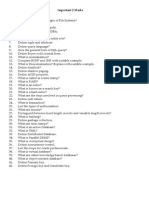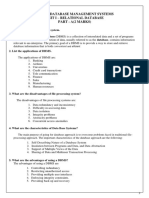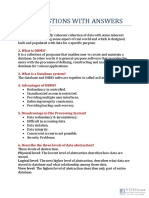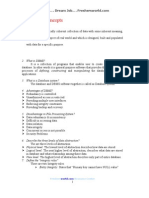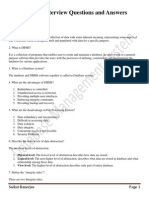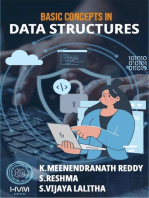Unit I Fundamentals Part A 1. Define Database Management System?
Unit I Fundamentals Part A 1. Define Database Management System?
Uploaded by
padminipugalendhiCopyright:
Available Formats
Unit I Fundamentals Part A 1. Define Database Management System?
Unit I Fundamentals Part A 1. Define Database Management System?
Uploaded by
padminipugalendhiOriginal Title
Copyright
Available Formats
Share this document
Did you find this document useful?
Is this content inappropriate?
Copyright:
Available Formats
Unit I Fundamentals Part A 1. Define Database Management System?
Unit I Fundamentals Part A 1. Define Database Management System?
Uploaded by
padminipugalendhiCopyright:
Available Formats
UNIT I FUNDAMENTALS PART A 1. Define database management system?
Database management system (DBMS) is a collection of interrelated data and a Set of programs to access those data. 2. List few applications of DBMS. a) Banking b) Airlines c) Universities d) Credit card transactions e) Tele communication f) Finance g) Sales h) Manufacturing i) Human resources 3. What are the disadvantages of file processing system? The disadvantages of file processing systems are a) Data redundancy and inconsistency b) Difficulty in accessing data c) Data isolation d) Integrity problems e) Atomicity problems f) Concurrent access anomalies
4. What are the advantages of using a DBMS? The advantages of using a DBMS are a) Controlling redundancy b) Restricting unauthorized access c) Providing multiple user interfaces d) Enforcing integrity constraints. e) Providing back up and recovery 5. Give the levels of data abstraction? a) Physical level b) logical level c) view level 6. Define instance and schema? Instance: Collection of data stored in the data base at a particular moment is called an Instance of the database. Schema: The overall design of the data base is called the data base schema. 7. Define the terms 1) physical schema 2) logical schema. Physical schema: The physical schema describes the database design at the physical level, which is the lowest level of abstraction describing how the data are actually stored. Logical schema: The logical schema describes the database design at the logical level, which describes what data are stored in the database and what relationship exists among the data.
8. What is conceptual schema? The schemas at the view level are called subschemas that describe different views of the database. 9. Define data model?
A data model is a collection of conceptual tools for describing data, data relationships, data semantics and consistency constraints. 10. What is storage manager? A storage manager is a program module that provides the interface between the low level data stored in a database and the application programs and queries submitted to the system. 11. What are the components of storage manager? The storage manager components include a) Authorization and integrity manager b) Transaction manager c) File manager d) Buffer manager 12. What is the purpose of storage manager? The storage manager is responsible for the following a) Interaction with he file manager b) Translation of DML commands in to low level file system commands c) Storing, retrieving and updating data in the database 13. List the data structures implemented by the storage manager. The storage manager implements the following data structure a) Data files b) Data dictionary c) indices 14. What is a data dictionary? A data dictionary is a data structure which stores meta data about the structure of the database ie. the schema of the database.
15. What is an entity relationship model? The entity relationship model is a collection of basic objects called entities and relationship among those objects. An entity is a thing or object in the real world that is distinguishable from other objects. 16. What are attributes? Give examples. An entity is represented by a set of attributes. Attributes are descriptive properties possessed by each member of an entity set. Example: possible attributes of customer entity are customer name, customer id, customer street, customer city. 17. What is relationship? Give examples A relationship is an association among several entities. Example: A depositor relationship associates a customer with each account that he/she has. 18. Define the terms i) Entity set ii) Relationship set Entity set: The set of all entities of the same type is termed as an entity set. Relationship set: The set of all relationships of the same type is termed as a relationship set. 19. Define single valued and multivalued attributes. Single valued attributes: attributes with a single value for a particular entity are called single valued attributes. Multivalued attributes: Attributes with a set of value for a particular entity are called multivalued attributes. 20. What are stored and derived attributes? Stored attributes: The attributes stored in a data base are called stored attributes. Derived attributes: The attributes that are derived from the stored attributes are called derived attributes. 21. What are composite attributes? Composite attributes can be divided in to sub parts.
22. Define null values. In some cases a particular entity may not have an applicable value for an attribute or if we do not know the value of an attribute for a particular entity. In these cases null value is used. 23. Define the terms i) Entity type ii) Entity set Entity type: An entity type defines a collection of entities that have the same attributes. Entity set: The set of all entities of the same type is termed as an entity set. 24. What is meant by the degree of relationship set? The degree of relationship type is the number of participating entity types. 25. Define the terms i) Key attribute ii) Value set Key attribute: An entity type usually has an attribute whose values are distinct from each individual entity in the collection. Such an attribute is called a key attribute. Value set: Each simple attribute of an entity type is associated with a value set that specifies the set of values that may be assigned to that attribute for each individual entity. 26. Define weak and strong entity sets? Weak entity set: entity set that do not have key attribute of their own are called weak entity sets. Strong entity set: Entity set that has a primary key is termed a strong entity set. 27. What does the cardinality ratio specify? Mapping cardinalities or cardinality ratios express the number of entities to which another entity can be associated. Mapping cardinalities must be one of the following: One to one One to many Many to one Many to many 28. Explain the two types of participation constraint.
Total: The participation of an entity set E in a relationship set R is said to be total if every entity in E participates in at least one relationship in R. Partial: if only some entities in E participate in relationships in R, the participation of entity set E in relationship R is said to be partial. 29. Define the terms i) DDL ii) DML DDL: Data base schema is specified by a set of definitions expressed by a special language called a data definition language. DML: A data manipulation language is a language that enables users to access or manipulate data as organized by the appropriate data model. 30. Write short notes on relational model The relational model uses a collection of tables to represent both data and the relationships among those data. The relational model is an example of a record based model. 31. Define tuple and attribute Attributes: column headers Tuple: Row 32. Define the term relation. Relation is a subset of a Cartesian product of list domains. 33. Define tuple variable Tuple variable is a variable whose domain is the set of all tuples.
PART B
1. What are various components of Database System? Explain in detail. 2. What do you mean by data models? Explain network, hierarchical and relational model in detail. 3. Explain various levels of Data abstraction in database system? 4. What do you mean by database? What is the purpose of a database system? Explain. 5. What do you mean by DBMS? Explain its functioning. 6. Explain architecture of DBMS and its advantages? state two main disadvantages of DBMS ? 7. What is DBA ? What are major responsibilities of DBA and database designers ? 8. What are problems with traditional file processing system ? How they are removed in database system ? Explain 9. What do you mean by Entity-Relationship Diagram? Explain 10.Explain the various terms of an E-R model and how are they represented in an E-R model 11.Describe the three-level architecture of DBMS ? Also explain its importance in a database environment. 12. Discuss concept of database language and interfaces 13. Explain the architecture of DBMS with a neat block diagram 14. Explain ER model in detail 15. Explain the design issues of ER-model 16. Explain the various relational algebra operations 17. Draw an ER diagram for a banking enterprise
You might also like
- Dbms Important QuestionsDocument14 pagesDbms Important Questions0502ravi100% (1)
- Cs 2255 Database Management SystemsDocument48 pagesCs 2255 Database Management SystemsnofeelingrahulNo ratings yet
- CS2255 DATABASE MANAGEMENT SYSTEMS (2marks and 16 Marks) Unit-I Part-ADocument32 pagesCS2255 DATABASE MANAGEMENT SYSTEMS (2marks and 16 Marks) Unit-I Part-ASekar PierceNo ratings yet
- Bca II Sem Dbms Question Bank With AnswersDocument35 pagesBca II Sem Dbms Question Bank With Answersadhura.khwab417No ratings yet
- CS3492 DBMS-Important-2-Mark With AnswerDocument16 pagesCS3492 DBMS-Important-2-Mark With Answersvkarthik83No ratings yet
- Database Management SystemsDocument42 pagesDatabase Management SystemsMehedi Hasan67% (3)
- 2 Marks Questions and AnswersDocument24 pages2 Marks Questions and AnswersIjaz D RoxZzNo ratings yet
- DBMS 2 MarksDocument21 pagesDBMS 2 MarksBabu KumarNo ratings yet
- Cs6302 Dbms Part ADocument16 pagesCs6302 Dbms Part Avenkatesan.vrs1No ratings yet
- Cse DBMS 2marksDocument14 pagesCse DBMS 2marksesmani84No ratings yet
- DBMSDocument13 pagesDBMSMathan NaganNo ratings yet
- DBMS 2marksDocument33 pagesDBMS 2markspalaniperumal041979No ratings yet
- Dbms All Units 2 MarksDocument28 pagesDbms All Units 2 Marksdudekulabalabrahmam143No ratings yet
- Dbms QBDocument28 pagesDbms QBJanani SatheshkumarNo ratings yet
- CS6302 DBMS 2marksDocument33 pagesCS6302 DBMS 2marksSathyamurthy Duraikkannu100% (2)
- Unit: 1: Two MarksDocument45 pagesUnit: 1: Two MarksbushemmyNo ratings yet
- Unit: 1: Database Management SystemsDocument32 pagesUnit: 1: Database Management SystemsLiNuNo ratings yet
- Database Management System 2mDocument24 pagesDatabase Management System 2mhddhlisfylajduw89eyrNo ratings yet
- RDBMS 2 MarksDocument24 pagesRDBMS 2 MarksRajesh RashtaNo ratings yet
- DBMS Unit I QuestionBankDocument6 pagesDBMS Unit I QuestionBankspecialise.cegNo ratings yet
- DBMS 2marksDocument29 pagesDBMS 2markssubbulakshmi VNo ratings yet
- 2 Mark - DBMSDocument12 pages2 Mark - DBMSG Sindhu RavindranNo ratings yet
- DBMS - 2 MarksDocument19 pagesDBMS - 2 MarksDr. A. Haja Abdul KhaderNo ratings yet
- DbmsDocument13 pagesDbmssrinivas maNo ratings yet
- DBMS Imp Questions AnswersDocument33 pagesDBMS Imp Questions Answerstikoya2311No ratings yet
- Two Mark Questions DBMSDDocument24 pagesTwo Mark Questions DBMSDVasantha KumariNo ratings yet
- DbmsDocument17 pagesDbmsAbin SurajNo ratings yet
- 1 QB104321 - 2013 - RegulationDocument4 pages1 QB104321 - 2013 - RegulationVenkanna Huggi H100% (1)
- RDBMS ConceptsDocument18 pagesRDBMS ConceptsparimalaseenivasanNo ratings yet
- Database 2Document19 pagesDatabase 2api-3814848No ratings yet
- Cs8492 - Database Management Systems Unit I - Relational Database Part - A (2 Marks)Document27 pagesCs8492 - Database Management Systems Unit I - Relational Database Part - A (2 Marks)Dr.P.L. Rajarajeswari CSE departmentNo ratings yet
- What Is Database?Document21 pagesWhat Is Database?Abhi XavierNo ratings yet
- Dbms Question PaperDocument4 pagesDbms Question PaperSasi PlacementsNo ratings yet
- DBMS - Interview Questions and Answers: Level 1Document30 pagesDBMS - Interview Questions and Answers: Level 1vvsprasadNo ratings yet
- RDBMS Concepts: How Many Numbers Are Divisible by 100 From 1 To 20 NoneDocument8 pagesRDBMS Concepts: How Many Numbers Are Divisible by 100 From 1 To 20 NoneVasantha KumariNo ratings yet
- Dbms Viva PDFDocument14 pagesDbms Viva PDFNeelesh ChandraNo ratings yet
- What Is A Database?: RDBMS Concepts - Basics & Interview QuestionsDocument8 pagesWhat Is A Database?: RDBMS Concepts - Basics & Interview QuestionsPiyush Raj SinhaNo ratings yet
- Rajalakshmi Engineering College: 1. What Is Database?Document10 pagesRajalakshmi Engineering College: 1. What Is Database?kandasamykumarNo ratings yet
- Two Marks: Unit: 1Document62 pagesTwo Marks: Unit: 1Super Hit MoviesNo ratings yet
- What Is Database?Document17 pagesWhat Is Database?AsadNo ratings yet
- Dbms 2 MarksDocument17 pagesDbms 2 MarksPraveen Kumar100% (1)
- Thiru DBMS Viva-FAQsDocument13 pagesThiru DBMS Viva-FAQsdmprashanth6No ratings yet
- Short Type Questions and Answers On: Biju Patnaik University of Technology, OdishaDocument27 pagesShort Type Questions and Answers On: Biju Patnaik University of Technology, Odishacrana10No ratings yet
- Dbms Viva QuestionsDocument33 pagesDbms Viva QuestionsSujy CauNo ratings yet
- DBMS Q & ADocument8 pagesDBMS Q & ADr. Hitesh MohapatraNo ratings yet
- DBMS Faq PDFDocument4 pagesDBMS Faq PDFSasi PlacementsNo ratings yet
- 18CST41 - DBMS Cat 1 Answer KeyDocument12 pages18CST41 - DBMS Cat 1 Answer Key20CSR064 Natchattira T SNo ratings yet
- Faq in DbmsDocument15 pagesFaq in DbmsSripriya GunaNo ratings yet
- DBMS Questions: Ramesh 1 RameshDocument86 pagesDBMS Questions: Ramesh 1 RameshKalyan MajjiNo ratings yet
- DBMSDocument21 pagesDBMSAbhisek SarkarNo ratings yet
- Dbms Viva Voice Questions and AnswersDocument23 pagesDbms Viva Voice Questions and Answersjyothibellaryv88% (8)
- RDBMS Concepts: Freshers Resource CenterDocument19 pagesRDBMS Concepts: Freshers Resource CenterRashmi MohanNo ratings yet
- DBMS - Interview Questions and Answers: Level 1Document30 pagesDBMS - Interview Questions and Answers: Level 1Gamindu UdayangaNo ratings yet
- Software Database Database SystemDocument17 pagesSoftware Database Database SystemHanu4abapNo ratings yet
- Yyyyy Yyyyy Yyyyy Yyyyy YyyyyDocument17 pagesYyyyy Yyyyy Yyyyy Yyyyy YyyyyProtyay RoyNo ratings yet
- THE SQL LANGUAGE: Master Database Management and Unlock the Power of Data (2024 Beginner's Guide)From EverandTHE SQL LANGUAGE: Master Database Management and Unlock the Power of Data (2024 Beginner's Guide)No ratings yet
- DATABASE From the conceptual model to the final application in Access, Visual Basic, Pascal, Html and Php: Inside, examples of applications created with Access, Visual Studio, Lazarus and WampFrom EverandDATABASE From the conceptual model to the final application in Access, Visual Basic, Pascal, Html and Php: Inside, examples of applications created with Access, Visual Studio, Lazarus and WampNo ratings yet
- SapDocument8 pagesSapviveksinghchdNo ratings yet
- DS Toolbox DataScienceGeniusDocument1 pageDS Toolbox DataScienceGeniusSandeep SaurabhNo ratings yet
- Frecuency MeterDocument17 pagesFrecuency MeterBasilio FarachNo ratings yet
- Compare Blocks - ResultsDocument19 pagesCompare Blocks - ResultsBramantika Aji PriambodoNo ratings yet
- ZOS Catalog and VSAM Best PracticesDocument28 pagesZOS Catalog and VSAM Best PracticesoparikokoNo ratings yet
- Intermediate Code Generation in Compiler Design: The Benefits of Using Machine Independent Intermediate Code AreDocument2 pagesIntermediate Code Generation in Compiler Design: The Benefits of Using Machine Independent Intermediate Code AremeenasiNo ratings yet
- 124MS Logic and Sets: Closed Book ExaminationDocument7 pages124MS Logic and Sets: Closed Book ExaminationSezen MolageanNo ratings yet
- DBMS Introduction: COMP3311 Database Management SystemsDocument25 pagesDBMS Introduction: COMP3311 Database Management SystemsElizabeth ChanNo ratings yet
- Multithreaded Programming Using Java Threads: Praveenraj R (Mark Education Academy)Document46 pagesMultithreaded Programming Using Java Threads: Praveenraj R (Mark Education Academy)Rakesh. N murthyNo ratings yet
- Tms 320 C 6713 BDocument154 pagesTms 320 C 6713 BhemanthnagNo ratings yet
- Design Patterns Are Proven, ReusablDocument2 pagesDesign Patterns Are Proven, Reusablbitran paulNo ratings yet
- PC Unit II NotesDocument56 pagesPC Unit II Notesjagan.venkatesan11No ratings yet
- Resume of Dturpin92Document1 pageResume of Dturpin92api-25229215No ratings yet
- U900 Deployment Considerations - VDocument14 pagesU900 Deployment Considerations - VZamroniMohammadNo ratings yet
- Pylint DocsDocument183 pagesPylint DocsVernonNo ratings yet
- DSsyllabusDocument6 pagesDSsyllabusaarzu qadriNo ratings yet
- Graph Tree NotesDocument76 pagesGraph Tree Notesabhishek vermaNo ratings yet
- St. Kabir Institute of Professional StudiesDocument12 pagesSt. Kabir Institute of Professional Studiespatel nilayNo ratings yet
- Chapter 2 Quadratic Expressions and Equations (2) - 4CDocument9 pagesChapter 2 Quadratic Expressions and Equations (2) - 4CCheng WLNo ratings yet
- 1756-Pm008 Logix5000 Ladder DiagramDocument20 pages1756-Pm008 Logix5000 Ladder DiagramAnojan BalaNo ratings yet
- Recurrent Neural NetworkDocument10 pagesRecurrent Neural NetworkDechasa ShimelsNo ratings yet
- Self Service SystemDocument78 pagesSelf Service Systemdeoankit0099No ratings yet
- E CommerceDocument10 pagesE CommerceDev TiwariNo ratings yet
- AKSHAR: A Mechanism For Inputting Indic Scripts On Digital DevicesDocument11 pagesAKSHAR: A Mechanism For Inputting Indic Scripts On Digital DevicesHappy RajputNo ratings yet
- Bates Rowing Order Form: TotalDocument1 pageBates Rowing Order Form: TotaltguncikNo ratings yet
- RevisionsDocument161 pagesRevisionsmolaNo ratings yet
- 8 Maths NCERT Solutions Chapter 1 1Document6 pages8 Maths NCERT Solutions Chapter 1 1knarasimhareddyNo ratings yet
- MA Viva BankDocument9 pagesMA Viva BankManish NarkhedeNo ratings yet
- 3gp ConverterDocument1 page3gp ConverterandreasbayuNo ratings yet
- Atode (あとで) -Document1 pageAtode (あとで) -nehalNo ratings yet






















